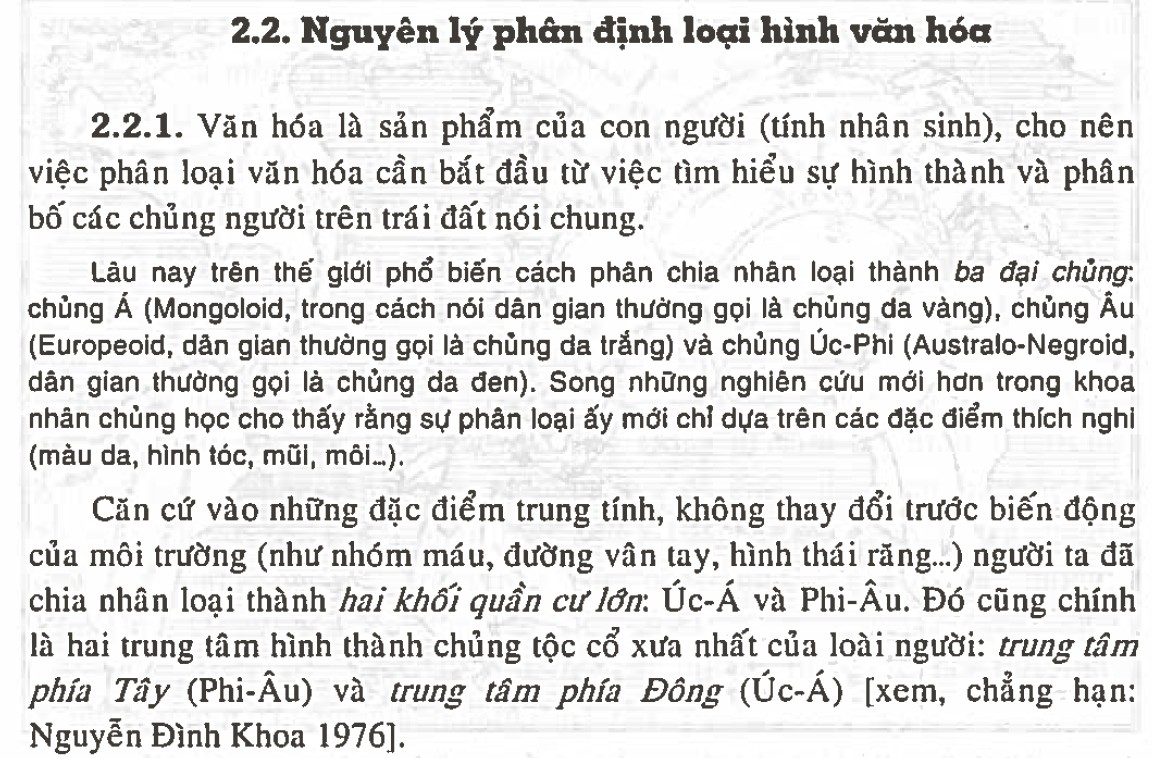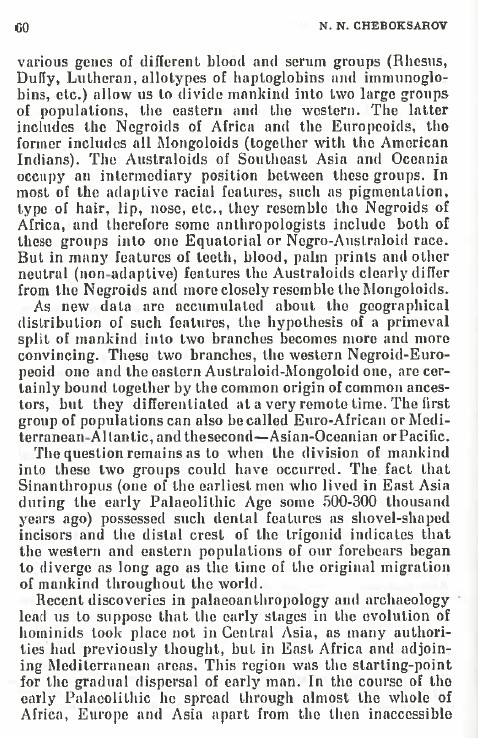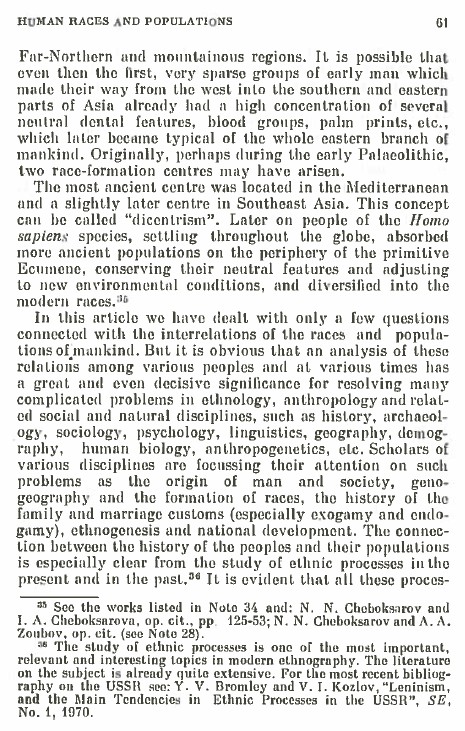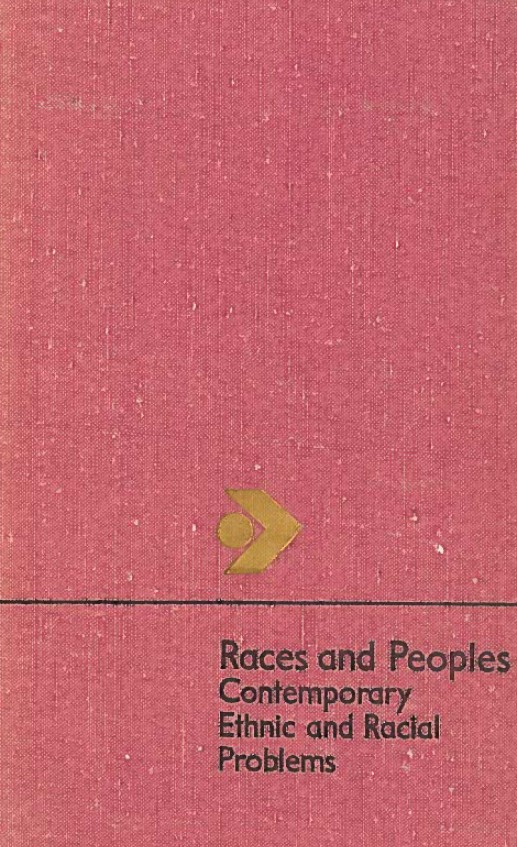So I was reading Trần Ngọc Thêm’s Searching for the True Nature of Vietnamese Culture (Tìm về bản sắc văn hóa Việt Nam), a textbook on Vietnamese culture that has been widely used in Vietnamese universities for the past 20 years, when it dawned on me that some of the ideas that are expressed in that book are simply racist.
Essentially what Trần Ngọc Thêm does in this book is to say that the Vietnamese are better than other people and that this superiority is the result of the interplay of such factors as race, environment, and culture.

How does he make this point? Well, there are many elements to his argument, and he also makes many mistakes along the way as he misquotes and misunderstands the works that he cites to make his argument.
As such, it takes a lot of work to “untangle” the ideas with the misinformation. I will try to do so over the next few blog posts, but let’s start with one basic point that Trần Ngọc Thêm makes early in his book – that there is a connection between culture and race.
Trần Ngọc Thêm first makes the comment that culture is created by humans (văn hóa là sản phẩm của con người). That’s fine.
However, he then goes on to say that “therefore, the categorization of cultures must begin with an understanding of the formation and distribution of human races on the earth in general.” (cho nên việc phân lọai văn hóa cần bắt đầu từ việc tìm hiểu sự hình thành và phân bố các chủng người trên trái đất nói chung)
In other words, according to Trần Ngọc Thêm in order to understand culture as a product of human beings, we first need to understand the racial divisions of human beings and their distribution across the globe. . .
Why would that be important? Is Trần Ngọc Thêm arguing that one’s racial makeup has some influence over the type of culture that one produces?
Indeed, although his ideas are at times unclear, this is the point that comes through in this work.

Trần Ngọc Thêm states that whereas in the past scholars had argued that there were three main human races (the Mongoloid, the Europeoid and the Australo-Negriod), it is now more common to divide human kind into two main groups.
He then cites the work of Soviet ethnographer, Nikolai Nikolaevich Cheboksarov, who argued in the early 1970s that evidence of the distribution of certain shared physical traits “allow us to divide mankind into two large groups of populations, the eastern and the western. The latter includes the Negroids of Africa and the Europeoids, the former includes all Mongoloids (together with the American Indians).” (60)

This “primeval split,” Cheboksarov argued, took place in the early Paleolithic as early human migrated away from Africa and was the result of the emergence of two “race-formation centers” an earlier one in northern Africa and southwest Asia, and a slightly later one in Southeast Asia.
Then, according to Cheboksarov, “Later on people of the Homo sapiens species, settling throughout the globe, absorbed more ancient populations on the periphery of the primitive Ecumene, conserving their neutral features and adjusting to new environmental conditions, and diversified into the modern races.”
In other words, while Cheboksarov did argue that there was “a primeval split of mankind into two branches,” he also argued that there were two waves of human migration out of Africa. The “primeval split” occurred in the first wave with its two “race-formation centers” that created certain physical characteristics that “allow us to divide mankind into two large groups of populations.”
However, he also argued that there was then a second wave, consisting of Homo sapiens, that “absorbed more ancient populations” (did he mean Homo erectus?). Through that process of absorption, they obtained some of the physical characteristics of the absorbed populations. However, according to Cheboksarov, they also adjusted to new environmental conditions.

So while Cheboksarov saw some continuity in the presence of certain physical features among human populations in different parts of the globe, he also argued that human beings changed over time as well.
This was very much in line with the ideas of other Soviet anthropologists in the twentieth century who categories such as “race,” “ethnicity” and “culture” were all fluid and malleable.
They were also opposed to the practice of linking physical traits with behavior or ideas, and saw such “racialism” as an “imperial ideology” of America and its allies. Indeed, Cheboksarov himself argued against such practices.

Trần Ngọc Thêm was either unaware of these Soviet views or chose to ignore them as he used Cheboksarov’s claim of a “primeval split” of certain physical features as evidence for a deep cultural divide between the same peoples that Cheboksarov mentioned (Negroids of Africa and the Europeoids versus the Mongoloids).
In citing the passage about Homo sapiens migrating across the globe, Trần Ngọc Thêm left out the information about them asbording the earlier, divided population. This is what he wrote (I don’t have access to the 1971 Russian-language work that Trần Ngọc Thêm cites, but this 1974 English-language chapter cites that same 1971 source and it’s clear that the information is the same):
“Those people later still who were members of the modern Homo sapien species gradually spread across the globe. . . and although they conserved many neutral features, at the same time they adjusted to new natural conditions, and gradually diversified into the races of today.”

This quote is confusing because Trần Ngọc Thêm omits information from the original that makes this passage comprehensible. The information that Trần Ngọc Thêm omits is also information that shows that Cheboksarov’s ideas were more complex than arguing that there is an ancient divide between human populations.
Trần Ngọc Thêm’s simplified version of Cheboksarov’s ideas, however, fits with his mission which is to demonstrate that there is an ancient human divide and that this division accounts for a massive cultural divide between “the East” and “the West.”
Although Trần Ngọc Thêm says at one point that the East-West divide is “entirely based on geography” (thuần túy dựa vào địa lý), he devotes a page to providing examples of the supposed cultural differences between these two regions: people in the West shake hands, people in the East bow; people in the West value the individual, people in the East value the community.
He also cites South Vietnamese philosopher Lương Kim Định for an example for the idea that the East is “static” (tĩnh chỉ) and the West is “dynamic” (động đích). This was initially a derogatory statement that Euro-Americans made about Asia in the nineteenth century, but Kim Định and Trần Ngọc Thêm, as I will explain later, inverted this expression and make the “static” nature of the East superior to the West’s “dynamism.”
And finally, Trần Ngọc Thêm misquotes “the famous poem of the English poet, [Rudyard] Kipling, who spent many years in India”:
Oh, East is East, and West is West,
Never the twain shall meet, till the Earth and the Sky meet. . .
But if there was no East then how on earth could there be a West!

First of all, there is no line in the poem that says “But if there was no East then how on earth could there be a West!) (Nhưng nếu không có phương Đông thì làm gì có phương Tây!
Second, the point of this poem is the opposite of what that first line implies. The poem is about an Afghan horse thief and an English officer who develop a sense of respect for each other. It does not support the idea that there is an East-West cultural divide.

It is easy to get lost in all of Trần Ngọc Thêm’s misunderstandings, misquotes and contradictions, but if we put those aside and try to follow his point, we see that he is attempting to say that there is a major cultural divide between “the East” and “the West,” and that this cultural divide has deep roots that we can ultimately trace back to early human racial divisions.
As we will see later, Trần Ngọc Thêm does not see this divide as creating equal halves. The East is superior, and the Vietnamese inhabit a supreme place in the East.
Indeed, as we will see, this is an argument for Việt supremacy.


This Post Has 2 Comments
Looking forward to reading your next few blog posts. Race aside, is it possible that Trần Ngọc Thêm is the Fuhrer’s reincarnation?
Germans are known for their precision. There is a severe lack of precision in TNT’s scholarship, so I don’t think that reincarnation theory works. . . 🙂
I’ve been reading a book called Empire of Nations
Ethnographic Knowledge and the Making of the Soviet Union by Francine Hirsch. There is a chapter in the book which looks at how Soviet anthropologists started working very hard in the 1930s to counter German ideas about the link between race and culture (which also argued that a lot of the “races” in the Soviet Union were incapable of “advancing”).
So my guess would be that if we could bring N. N. Cheboksarov back to life and have him read TNT’s book, he would not be pleased. The idea that there is a link between race and culture is one that Cheboksarov and his fellow Soviet anthropologists worked hard to refute. As it turns out, this idea also came to be refuted in the land of the Soviet Union’s enemy, the US.
But it lives on in Vietnam. . .